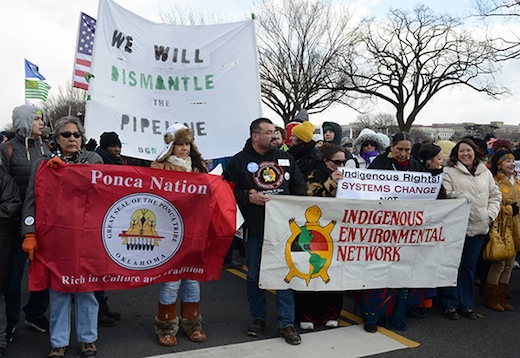
On this day in 1890, the “tragedy of the Ponca Indians led to Nebraska’s last significant land acquisition,” when President Benjamin Harrison issued a proclamation that extended the northern boundary of Nebraska into the Dakota territory. The decree also declared that all Indian claims to Nebraska territory have been officially “extinguished.” The order required the Ponca to take allotments even though most tribal members were opposed to it. “Ponca traditionalists formed a strong anti-allotment faction. In 1887, Congress passed the General Allotment Act (Dawes Act), which had the intent of assimilating Indians by making them land-owning farmers. The idea of the Dawes Act was to break up the reservations by giving each Indian family an allotment of land, similar to the homesteads given to non-Indian settlers. This act guided much of the Indian policy during the Harrison administration (1889-1892),” says Native American Roots website.
Harrison was the grandson of famed “Indian fighter” and treaty negotiator William Henry Harrison, who served one month as president in 1841 before succumbing to illness.
The story of how the northern boundary of Nebraska was negotiated includes government ineptitude and bad faith, political manipulation, and the total disruption of the Poncas’ lives.
Nebraska Studies writes:
The Ponca Tribe signed several treaties with the federal government from 1817 to 1865. Like numerous other tribes in Nebraska, they were forced to witness the shrinking of their homelands until most were moved to the Indian Territory in the present day state of Oklahoma.
The United States government signed four treaties with the Poncas before ending the treaty-making procedure to formalize relations between them and the Indians. Treaties were signed with the Ponca in 1817, 1825, 1858, and 1865. The third and fourth treaties are the most significant with reference to the 1879 Standing Bear v. Crook court case.
In 1858, the Ponca ceded a large section of land to the U.S. Government, but they did reserve a much smaller area for the tribe to occupy. They agreed to move to the reserved area within one year after ratification of the treaty. The new area would become their permanent home. In return for making the land cession, they were to receive the following from the U.S. Government:
- Annuities – that is, cash payments – for 30 years
- Educational institutions for ten years
- A mill to grind grain and one to saw timber
- An interpreter, a miller, a mill engineer, and a farmer
As the Commissioner for Indian Affairs explained in his 1858 Report, the objective was to “colonize and domesticate” the Poncas.
The Ponca planned to give up hunting for an agricultural economy. However, they faced a variety of problems that included: failure of the government to live up to its promises, drought, locust, and conflicts with the Sioux. Yet, the Ponca kept their promises and never stole from nor attacked the white man.
The case of Standing Bear v. Crook refers to the famous Ponca chief, Standing Bear and U.S. General Crook. In 1879, after losing one-third of his tribe to malaria and deplorable reservation conditions, Standing Bear returned to the tribe’s land in Nebraska to bury his son, a casualty of the U.S. government’s policy. The federal government ordered Standing Bear’s arrest for leaving Indian Territory without permission. The arrest order trickled down the line of communications from General Sherman in Washington, to General Sheridan in Chicago, to General Crook in Omaha.
Standing Bear filed a suit of habeas corpus against the U.S. government, challenging the grounds for his arrest.
In a trial widely publicized in the Omaha Herald by journalist Susette La Flesche Tibbles, whose grandmother was Ponca, and her husband Thomas H. Tibbles, the judge ordered Standing Bear to be released as he was arrested and held illegally. In his ruling, Judge Elmer Dandy wrote, “an Indian is a person within the meaning of the law,” establishing that Standing Bear had rights under U.S. law. The decision served as a catalyst for the Native people’s rights movement in general and for the Ponca people in particular. Standing Bear along with La Flesche campaigned and traveled to promote the cause. Standing Bear buried his son, Bear Shield, in the “soil of his ancestors.”
Federal recognition of the Ponca tribe was officially terminated in 1966. But after years of pressure, on October 31, 1990, 100 years after Harrison’s proclamation, President George H.W. Bush reinstated the tribe, establishing their right to their homeland in the state of Nebraska.
Sources:
History Channel: http://www.history.com/this-day-in-history/president-benjamin-harrison-extends-borders-of-nebraska
National Parks Service: http://www.nps.gov/mnrr/historyculture/upload/Standing%20Bear.pdf
Native American Roots: http://nativeamericannetroots.net/diary/1697
Nebraska State Historical Society: http://www.nebraskahistory.org/publish/publicat/history/full-text/NH2006BoydCounty.pdf
Nebraska Studies: http://www.nebraskastudies.org/0600/frameset_reset.html?http://www.nebraskastudies.org/0600/stories/0601_0107.html
Compiled by Teresa Albano
Photo: The Ponca Nation stands with the Indigenous Environmental Network protesting the Keystone XL Pipeline at a 2013 climate action protest in Washington, D.C. (Stephen Melkisethian/CC)












Comments